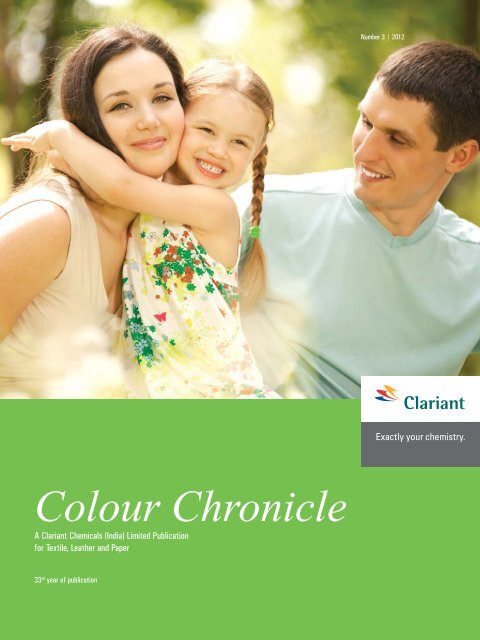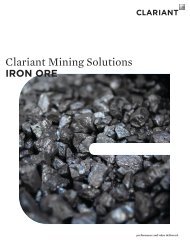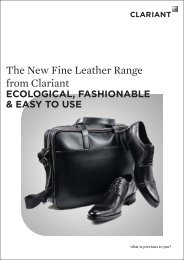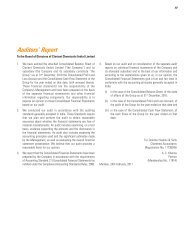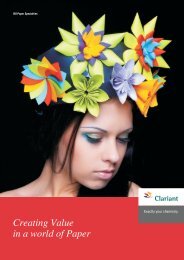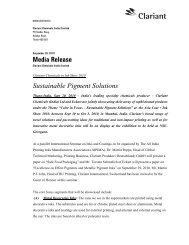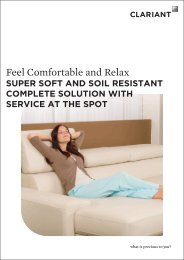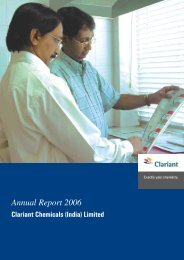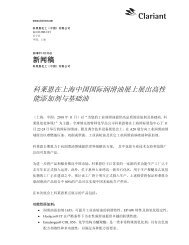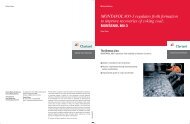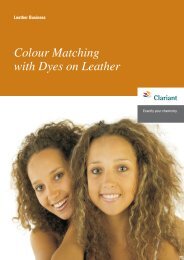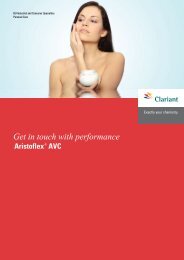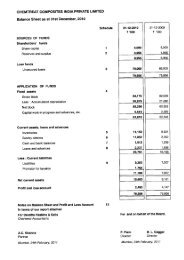Colour Chronicle - Sept 2012 - Clariant
Colour Chronicle - Sept 2012 - Clariant
Colour Chronicle - Sept 2012 - Clariant
Create successful ePaper yourself
Turn your PDF publications into a flip-book with our unique Google optimized e-Paper software.
Number 3 | <strong>2012</strong><br />
<strong>Colour</strong> <strong>Chronicle</strong><br />
A <strong>Clariant</strong> Chemicals (India) Limited Publication<br />
for Textile, Leather and Paper<br />
33 rd year of publication
colour chronicle 3 | <strong>2012</strong><br />
Contents<br />
Textile 3<br />
Pekoflam® ECO/SYN<br />
Leonil D-Air<br />
Foron Vermillion – S-WF<br />
Soil & Stain Release<br />
Drimaren® HF Reactive Dyes<br />
Paper 12<br />
Stronger Colors with Cartafix®<br />
Leather 18<br />
<strong>Clariant</strong> Supports Innovations in Sustainability<br />
Gleanings from press 21<br />
2 colour chronicle 3 | <strong>2012</strong>
textile<br />
Pekoflam ® ECO/SYN<br />
A new generation of flame retardants<br />
Bedding & Nightwear<br />
Market segments for flame retardant<br />
textiles<br />
The use of flame retardants is generally required<br />
where fire is a safety hazard of high concern and<br />
where strict regulations need to be matched to protect<br />
human lives.<br />
Common finishing technology for wash<br />
durable cotton<br />
Ammonia curing process<br />
Exclusive technology for > 30 years<br />
X-linkage on fabric with NH3 for highest durability<br />
with high alkaline resistance, applicable for work<br />
wear, home textiles, garments, night-wear, T-shirts<br />
etc., incl. PES / CEL blends, and at high dosage for<br />
lower fabric weights, but requires excessive washes<br />
to remove high level of formaldehyde.<br />
Reactive process, acid catalyzed<br />
Industrial state of the art since > 40 years<br />
Requires resins in combination with catalytic acid<br />
to achieve pH 2, and results in significantly reduced<br />
tensile strength, therefore limited to medium to<br />
heavier weight fabrics, and selected dyes. Reliably<br />
suitable only for cotton blends with ≤ 15% synthetic<br />
fiber contents.<br />
Finishing technology for wash<br />
durable cotton<br />
Pros and cons of established processes<br />
Organic phosphorus-urea precondensates<br />
for ammonia curing process on<br />
blends with more than 20% synthetic<br />
fiber content, for example our Pekoflam ®<br />
DCB or similar reference products.<br />
Excellent wash durability and<br />
performance even on blends with<br />
more than 20% synthetic fiber<br />
content.<br />
Requires special equipment.<br />
Formaldehyde emissions in processing<br />
require extensive washes.<br />
Reactive organic phosphonates used<br />
for cotton, as our Pekoflam ® DPN or<br />
comparable products from other flame<br />
retardant chemicals suppliers.<br />
Easy to apply on existing processing<br />
lines in textile mills.<br />
High level of stenter emissions<br />
frequently requires intense cleaning<br />
cycles.<br />
High impact on tensile strength<br />
limits fabric selection.<br />
Formaldehyde emissions on treated<br />
materials restrict its use for certain<br />
consumer markets.<br />
Novel technology for finishing of<br />
cotton and synthetic blends<br />
New Pekoflam ® ECO/SYN - Confidence<br />
in protection<br />
Suitable application segments and<br />
related fiber compositions.<br />
– Home textiles (CO-LI)<br />
– Tents & tarpaulins (CO-CO/PES)<br />
– Protective & military wear<br />
(CO / PA-CO / PES)<br />
– Nightwear (CO-CL)<br />
Public Transport<br />
Military<br />
Hospitals / Public Buildings<br />
Automotive Interiors<br />
Home furnishings<br />
Protective wear / Work wear<br />
Construction<br />
colour chronicle 3 | <strong>2012</strong> 3
textile<br />
Technical advantages<br />
– Processing on common finishing<br />
lines.<br />
– Suitable for cotton and selected<br />
natural and regenerated cellulosic<br />
fibres as well as blends with<br />
synthetics.<br />
– Very low impact on fabric strength<br />
allowing wider range of fabric<br />
selection and end-uses.<br />
– Safer processing due to absence of<br />
formaldehyde emissions.<br />
– No oily deposit formation in stenter<br />
compartments, as easily removable<br />
deposits are formed.<br />
– No ‘bad smell’ formation as<br />
observed with established reactive<br />
phosphonate chemistry.<br />
Novel technology for home<br />
textiles<br />
Pekoflam ® ECO/SYN liq.<br />
FR test* according to BS5852 source 5<br />
on a 260 gsm cotton interlining fabric:<br />
– Untreated fabric burns for more<br />
than 120s, whereas treated<br />
Novel technology for protective apparel<br />
Comparison Pekoflam ® ECO/SYN – Pekoflam ® DPN –<br />
Pekoflam ® DCB<br />
FR test according to EN15025 on a royal blue 290 gsm<br />
cotton protective wear fabric:<br />
– DPN treated fabric fails test after 100 domestic<br />
laundries, as flames reach upper mark within<br />
20 seconds, and material is completely charred.<br />
Comparison material treated with our new<br />
technology does not even ignite during contact with<br />
the gas burner flame, comparable to the ammonia<br />
cured fabric treated with DCB.<br />
Technological tests*:<br />
After 100 x 60°C washed Recipes ECO DPN DCB<br />
Phosphorus 2.3 0.4 1.9<br />
Nitrogen 2.3 0.6 1.3<br />
Flammability test according to DIN 15025<br />
(Ignition time 12s, vertical test, surface flaming, two specimens tested in each direction)<br />
After 100 x 60°C washed Recipes ECO DPN DCB<br />
burning duration [s] 0 35 0<br />
glow time [s] 0 0 0<br />
increase of glow [yes / no] No No No<br />
hole arised [cm / no] No No No<br />
burning / melting drops No No No<br />
number of drops 0 0 0<br />
flame reached the top and margins [yes/no] No Yes No<br />
Index 3 0 3<br />
(* done by <strong>Clariant</strong> lab)<br />
material self-extinguishes after<br />
roughly two minutes without<br />
progressive flaming nor any major<br />
mass loss observed.<br />
Benefits of novel finishing<br />
technology<br />
<strong>Clariant</strong>’s concept for sustainable<br />
protection:<br />
– SUSTAINABILITY: Suitable for<br />
renewable fiber materials.<br />
– PROTECTION: Safe handling and<br />
low environmental footprint.<br />
– ECOLOGY: No additional<br />
chemical consumption in rinsing<br />
and no fabric neutralization<br />
needed.<br />
– FLEXIBILITY: High strength<br />
retention enlarges material selection<br />
pool.<br />
– ECONOMY: Cost competitive to<br />
established concepts.<br />
4<br />
Untreated, after 15s Untreated, after 30s Treated, after 60s<br />
colour chronicle 3 | <strong>2012</strong><br />
Traditional concepts<br />
High formaldehyde emission levels.<br />
Limitations in processing.<br />
Limitations in fiber and weight<br />
selection.<br />
New concept<br />
No formaldehyde emissions.<br />
High flexibility in equipment selection.<br />
Broader application window allowing<br />
solutions other than cotton-based only.
textile<br />
Leonil D-Air<br />
New De-aerating Agent<br />
Characteristics<br />
It has excellent de-aerating property<br />
and thereby facilitates penetration<br />
of processing bath ingredients into<br />
difficult to penetrate cellulosic goods.<br />
It has additional power of strong wetting<br />
and foam-suppression capacity.<br />
Applicable in neutral, acidic and<br />
alkaline baths.<br />
Does not have retarding effect and does<br />
not disturb solubility of dyes.<br />
Prevents vat skinning and smears when<br />
dyeing with vat and sulphur dyes<br />
It is silicone oil free.<br />
De-aerating Power<br />
ref - ref + 2 gpl 2 gpl 2 gpl 2 gpl<br />
time/s iso-propyl water Leonil D- Antimussol Antimussol Leonil EHC<br />
alcohol Air liq UDF liq HTS liq liq conc<br />
0 232 232 232 232 232 232<br />
10 170 232 196 228 228 177<br />
20 170 230 189 225 222 174<br />
30 170 230 186 224 219 173<br />
60 170 230 183 221 213 172<br />
90 170 230 182 219 209 172<br />
120 170 229 181 218 206 172<br />
Total air in system : 232 - 170 = 62<br />
in % 100% 5% 82% 23% 42% 97%<br />
Remark: Iso-propyl alcohol is taken here as a reference system and considered to replace maximum<br />
air (de-aeration power)<br />
Wetting Property by Anchor Method (Alkaline Conditions NaOH 15 gpl)<br />
Wetting time (seconds)<br />
1000<br />
100<br />
10<br />
Liquor Stability with Sensitive<br />
Reactive Dyes<br />
8 g/l Drimaren Turquoise K-2B<br />
x g/l Product<br />
80 g/l Glauber Salt<br />
5 g/l Soda Ash<br />
2 ml/l NaOH 405g/l<br />
200 ml - 60 min / 40°C<br />
Then filter the solution through S & S filter<br />
Paper N° 589/2 under vaccum suction<br />
Leonil D-AIR liq<br />
Competition product A<br />
Competition product B<br />
Competition product C<br />
1<br />
0 0.5 1 1.5 2 2.5 3<br />
Concentration of wetting agent (g/l)<br />
Defoaming power under alkaline conditions (Reactive Dyeing)<br />
colour chronicle 3 | <strong>2012</strong> 5
textile<br />
Foron ® S-WF<br />
Today’s textile market has become highly<br />
competitive and is witnessing growing<br />
consumer awareness about quality. Under<br />
such conditions, products have to fulfill<br />
the most demanding requirements. In<br />
particular, end-customers are expecting<br />
constant innovation with features such as<br />
wash and wear, easy care and soft touch<br />
(with e.g. micro-fiber articles), together of<br />
course with vibrant and resistant colors.<br />
With the Foron ® S-WF dyestuffs, an<br />
evolution of the Foron ® S-type disperse<br />
dyes (pioneered by <strong>Clariant</strong> in the 1950s<br />
when still operating under the former<br />
Sandoz name), we do not only meet<br />
these requirements, but today can offer<br />
a conclusive range of dyestuffs that<br />
are able to cover the full scope of the<br />
most fashionable shades. Foron ® S-WF<br />
grades, with their market leading color<br />
fastness levels and highest sublimation<br />
fastness, enhance today’s textile products<br />
in the apparel, workwear and sportswear<br />
segments, whilst giving textile producers a<br />
<strong>Clariant</strong> has now developed two new dyestuffs to further consolidate this range.<br />
Foron Vermillion S-WF<br />
0.09% 0.27% 0.82% 2.46%<br />
Foron Atlantic Blue S-WF<br />
0.17% 0.52% 1.55% 4.65%<br />
state-of-the-art process with an improved<br />
environmental profile.<br />
The market-leading color consistency of<br />
Foron ® S-WF dyes enables a stable shade<br />
under different light sources, e.g. D65,<br />
CWF TL84 and Tungsten, minimizing<br />
metamerism issues.<br />
The Foron ® S-WF dye range covers<br />
a wide range of fashionable shades from<br />
yellows, oranges and reds, to blues, greens<br />
and navies, to blacks. Present range<br />
includes below elements –<br />
Foron ® Brilliant Yellow S-WF<br />
Foron ® Golden Yellow S-WF<br />
Foron ® Orange S-WF<br />
Foron ® Scarlet S-WF<br />
Foron ® Red S-WF<br />
Foron ® Rubine S-WF<br />
Foron ® Violet S-WF<br />
Foron ® Turquoise S-WF<br />
Foron ® Cyanine S-WF<br />
Foron ® Blue S-WF<br />
Foron ® Dark Blue S-WF<br />
Foron ® Navy S-WF<br />
Foron ® Carbon S-WF<br />
Foron ® Black S-WF<br />
Soil & Stain Release<br />
Increasing Customer Demands<br />
In various activities such as sports,<br />
work or daily life, our clothing not only<br />
often faces expected but also unexpected<br />
situations. Soil, oil, food or liquids might<br />
come into contact with our apparel, leaving<br />
stains which are often hard to remove or<br />
non- removable.<br />
At the same time consumers’ demand<br />
for protection and cleaning properties are<br />
constantly increasing. Therefore the trend<br />
towards soil repellent- and stain releaseimpregnation<br />
is growing, not least to avoid<br />
time consuming and costly cleaning and to<br />
ensure easy care and long life for all kind<br />
of fabrics.<br />
Effect Labels<br />
When customers are looking for clothes<br />
they can easily judge the color and the shape<br />
– but not all their properties. Therefore,<br />
it is absolutely vital to communicate<br />
functional effects such as water repellence,<br />
soil release, etc., which are not easy to<br />
see. These properties add value to the<br />
garments and are therefore a good selling<br />
proposition. This is why <strong>Clariant</strong> provides<br />
you with effect labels to help the customer<br />
recognize properties that are not visible at<br />
first sight. On the following pages, see how<br />
our solutions work for you!<br />
6<br />
colour chronicle 3 | <strong>2012</strong>
textile<br />
Sustainable Textile Protection for all Market<br />
Requirements<br />
Nuva ® N-Series<br />
<strong>Clariant</strong>’s Nuva ® products fulfill various state of the art demands<br />
concerning protection and care. These effects add innovative<br />
value to your textiles.<br />
Bedding<br />
Upholstery<br />
Casual Wear<br />
Outdoor Upholstery<br />
Consumer Benefits & Environmental Benefits<br />
Nuva ® N4547 liq – State of the Art Protection for Garments and Fabrics<br />
Performance benefits<br />
Excellent oil repellency.<br />
Dramatically improves stain release<br />
during laundering.<br />
Reduces the fabric’s absorption of soil<br />
and stain marks.<br />
Allows fabric to remain breathable.<br />
High durability of all effects.<br />
Mainly engineered for cellulosic<br />
material.<br />
Easy cleaning with no distress for<br />
sensitive fabrics.<br />
Does not change the textile handle.<br />
Wash and wear: stable together with<br />
glyoxal resins such as Arkofix ® ELF liq c,<br />
Arkofix ® NES liq.<br />
Environmental and safety benefits<br />
Preferred Technology as it is based on<br />
C6 chemistry.<br />
Free of PFOS (perfluorooctanyl<br />
sulfonate) and PFOA (perfluorooctanoic<br />
acid).<br />
Resources: saves energy and water.<br />
Less frequent laundering due to natural,<br />
moderate and highly durable repellency<br />
effect.<br />
Low temperature laundering – with<br />
highest quality of soil & stain release<br />
effect.<br />
Extended lifecycles for textile products.<br />
Safe and non-hazardous compounds<br />
with regards to consumer safety.<br />
Table<br />
Cloths<br />
Medical<br />
Sports Wear<br />
Work & Protective Wear<br />
Kids Wear<br />
colour chronicle 3 | <strong>2012</strong> 7
textile<br />
Nuva ®<br />
N4547 liq – State of the Art<br />
Protection for Garments and Fabrics<br />
Nuva ® N4547 liq provides excellent<br />
passive protection finishing for cellulosic<br />
fibers and fits nicely into a ‚‘wash and<br />
wear’ concept. The newly designed soil<br />
& stain release finish shows a natural<br />
moderate repellence effect against water,<br />
soil and stains, an excellent oil repellency<br />
and a very good air permeability effect.<br />
But it out-performs when stain and soil<br />
has been rubbed on or finds its way into<br />
the fiber through an immediate release of it<br />
during laundering.<br />
Furthermore, with Nuva ® N4547 liq,<br />
additional features can be added because<br />
the product shows the highest compatibility<br />
which results in a multifunctional finish.<br />
Tailor made Solutions<br />
for your Needs – your<br />
preferred Technology<br />
Nuva ® N-Series<br />
<strong>Clariant</strong> is a pioneer and an expert for<br />
innovative lifestyle garments and was<br />
one of the first to develop and improve<br />
the fluorobased finishes in textile. We<br />
focus on the most effective, innovative<br />
and sustainable products and processes<br />
and care for consumer demands and our<br />
environment through responsible use of<br />
our earth’s resources.<br />
Natural moderate repelling Very good repelling effect of: Very good effect of:<br />
effect of:<br />
Water Oil Air permeability<br />
Stains are removed faster and easier during laundering!<br />
Unfinished fabric<br />
Fabric finished with Nuva ® N4547 liq<br />
A drop of oil spilled onto After pressing the oil drop After 1 home laundering<br />
the fabric<br />
into the fabric<br />
Soil Release test (according to AATCC 130) done with dirty motor oil.<br />
Passive Protection<br />
Nuva ®<br />
N4547 liq: Designed for passive<br />
protection and therefore fits nicely into<br />
a ‘wash and wear’ concept for cellulosic<br />
based textiles. Besides the fact that high<br />
oil repellence can be archived, the product<br />
shows highest compatibility which results<br />
in a multifunctional finish.<br />
Nuva ®<br />
N4118 liq: Fits into the current<br />
comfort requirement for cotton based<br />
textile materials used close to the skin.<br />
Besides its soil release behaviour, the finish<br />
shows good absorbency and can therefore<br />
be used as highly comfortable finish for<br />
active wear or shirting material.<br />
Active Protection<br />
Nuva ® N2114 liq: State of the art repellent<br />
product with key performance on cotton<br />
and polyamide. Highly efficient with the<br />
focus on outstanding durability.<br />
Nuva ® N2155 liq: Nonionic repellent<br />
product designed for the technical<br />
application field. High compatibility in<br />
combination with so far unmet performance.<br />
The LTC profile (low temperature curing)<br />
allows treatments for sensitive areas.<br />
Mainly recommended for synthetic<br />
materials<br />
5<br />
Nuva ® N4547<br />
Soil Release<br />
4<br />
3<br />
2<br />
Nuva ® N4118<br />
Hydrophilic<br />
Soil Release<br />
Classical<br />
Soil Release<br />
Classical<br />
hydro/oleophobic<br />
Nuva ® N2114<br />
Nuva ® N2155<br />
1<br />
Hydrophilic<br />
Hydrophobic<br />
8<br />
colour chronicle 3 | <strong>2012</strong>
textile<br />
Drimaren ® HF reactive dyes<br />
Meeting the requirements of the continuous dyer<br />
Concepts behind Drimaren ®<br />
dyes:<br />
Innovation<br />
Performance<br />
Sustainability<br />
Adaptability<br />
Reliability<br />
HF/HF-CD<br />
Main technical advantages<br />
Suitable for all continuous dyeing<br />
processes.<br />
Very high fixation values.<br />
Minimum amount of color passed into<br />
the effluent.<br />
Homogeneous substantivity of the<br />
Drimaren ® HF-CD ternary. Low initial<br />
tailing will be on-tone.<br />
Good diffusion and levelling properties<br />
Excellent solubility.<br />
Very high pad liquor stability (high<br />
alkaline stability).<br />
Similar reactivity for rapid fixation.<br />
Shade unaffected by prolonged fixation<br />
times: High alkaline stability of the<br />
dye-fiber bond.<br />
Excellent washing off properties.<br />
Meet modern fastness requirements.<br />
Continuous dyeing<br />
Drimaren ® HF reactive dyes are<br />
recommended for dyeing cellulosic fabrics<br />
and their blends by all continuous dyeing<br />
processes:<br />
Pad batch.<br />
Pad dry pad steam.<br />
Pad dry thermofix.<br />
Pad wet steam.<br />
Pad moist.<br />
SWIFT process for PES/CEL (pad dry<br />
thermosol pad steam).<br />
High flexibility and effective utilization of<br />
mill capacity.<br />
Current range<br />
Brill. Yellow HF-RL<br />
Golden Yellow HF-CD<br />
Golden Yellow HF-CD<br />
Scarlet HF-3G<br />
Red HF-CD<br />
Red HF-3B<br />
Dark Red HF-CD<br />
Aquamarine HF-CD<br />
Blue HF-RL<br />
Dark Blue HF-CD<br />
Royal Blue HF-CD<br />
Navy HF-GN<br />
Navy HF-B<br />
Green HF-5BL<br />
Innovation for continuous dyeing<br />
Drimaren ® Aquamarine HF-CD<br />
Drimaren ® Dark Blue HF-CD<br />
Drimaren ® Golden Yellow HF-CD<br />
Drimaren ® Navy HF-GN<br />
Drimaren ® Red HF-3B<br />
Drimaren ® Br´. Yellow HF-RL<br />
Positioning of Drimaren ® HF - Focus<br />
products for continuous dyeing<br />
High lightfast pale to medium shades<br />
Golden Yellow HF-CD<br />
Yellow HF-CD<br />
Red HF-CD<br />
Aquamarine HF-CD<br />
Brilliant green, blue and turquoise shades<br />
Brilliant Yellow HF-RL<br />
Green HF-5BL<br />
Aquamarine HF-CD<br />
Royal Blue HF-CD<br />
Medium to deep shades<br />
Golden Yellow HF-CD<br />
Red HF-3B<br />
Dark Red HF-CD<br />
Aquamarine HF-CD<br />
Dark Blue HF-CD<br />
Navy HF-GN<br />
Navy HF-B<br />
colour chronicle 3 | <strong>2012</strong> 9
textile<br />
Orange and scarlet shades<br />
Golden Yellow HF-CD<br />
Scarlet HF-3G<br />
Red HF-3B<br />
What are the main problems faced by the<br />
continuous dyer?<br />
Shade transfer from lab to production.<br />
Shade reproducibility from batch to<br />
batch in production.<br />
Meeting modern retailer and brand<br />
house fastness requirements.<br />
Shade reproducibility from batch to batch<br />
in production.<br />
What are the main issues faced by the<br />
continuous dyer?<br />
Fabric appearance, penetration and<br />
levelling.<br />
Dyestuff solubility.<br />
Face to back shade variation (emerized<br />
fabrics).<br />
Shade continuity along the length and<br />
width of the fabric (tailing/listing).<br />
Dyestuff migration during pre-drying.<br />
Dyestuff stability to alkaline hydrolysis.<br />
Washing off and wet fastness.<br />
Photochromism.<br />
Fastness properties of the individual<br />
dyestuff.<br />
Improving fabric appearance, penetration<br />
and levelling with Drimaren ® HF dyes.<br />
Dyestuffs with high diffusion are essential<br />
for:<br />
Tightly woven fabrics.<br />
Fabrics constructed from high twist<br />
yarns.<br />
Mercerized fabrics.<br />
Regenerated cellulose, linen and<br />
cellulosic blends (CO:CV, CO:FL).<br />
Emerized fabrics (to improve face to<br />
back shade difference).<br />
Dyestuff stability to alkaline hydrolysis<br />
What can be done to minimize alkaline<br />
hydrolysis?<br />
Automatic liquor dosing systems (ratio<br />
4:1).<br />
Low volume economizer trough (fast<br />
pad liquor turnover time).<br />
Increase the amount of sodium silicate<br />
in the pad batch process (70 ml/l /<br />
38°Bé).<br />
Control of the fixation time and<br />
temperature.<br />
Control of the washing off conditions<br />
(mono VS dyes sensitive to alkaline<br />
washing).<br />
Cooling cylinders are used to cool and<br />
level out the fabric temperature before<br />
padding.<br />
Cooling water jackets around the pad<br />
trough are used to maintain the desired<br />
pad liquor temperature.<br />
Process water cooling systems for<br />
preparation of the dye and alkali<br />
solutions.<br />
Use reactive dyestuffs with high<br />
alkaline stability.<br />
Washing off reactive dyes<br />
Excellent wash and wet fastness properties<br />
can only be achieved by complete removal<br />
of the hydrolyzed dye, alkali and auxiliary<br />
chemicals during a washing off process.<br />
Very high fixation values.<br />
A high level of fixation is essential for<br />
good shade reproducibility, easier washing<br />
out of the unfixed dye and to minimize<br />
the amount of color that passes into the<br />
effluent.<br />
Brill. Yellow HF-RL .................. 96%<br />
Golden Yellow HF-CD ............... 96%<br />
Yellow HF-CD ............................. 92%<br />
Red HF-CD ................................. 90%<br />
Red HF-3B .................................. 97%<br />
Dark Red HF-CD ........................ 98%<br />
Aquamarine HF-CD .................. 90%<br />
Blue HF-RL ................................. 90%<br />
Dark Blue HF-CD ....................... 93%<br />
Royal Blue HF-CD ..................... 90%<br />
Navy HF-GN ............................... 95%<br />
Navy HF-B .................................. 97%<br />
Exchange Phase 1 > Diffusion & Desorption Phase > Exchange Phase 2<br />
10<br />
colour chronicle 3 | <strong>2012</strong>
Who helped to make my<br />
favorite carpet so comfortable?<br />
title<br />
<strong>Clariant</strong> – Your partner for individual carpet procedures.<br />
As new challenges emerge, carpets must meet steadily rising requirements at home, in the office, in<br />
public areas, hotels, airplanes and cars. Carpets and textile ground coverings must fulfill technical requirements<br />
such as soil and water repellence or wear-resistance while also meeting the demands of color,<br />
design and comfort. This is where <strong>Clariant</strong> can help you. We are committed to developing products for<br />
individualized carpet applications that comply with international regulatory standards. Our innovative<br />
products and services, long lasting experience and technical know-how play a key role in manufacturing<br />
and treating, from spinning and dyeing to finishing. <strong>Clariant</strong> is close to you. Any time. Any place.<br />
<strong>Clariant</strong> Chemicals (India) Limited, Sandoz Baug, Kolshet Road, Thane (W) 400 607. www.clariant.in<br />
What do you need?<br />
colour chronicle 3 | <strong>2012</strong> 11
paper<br />
Stronger Colors with Cartafix ®<br />
<strong>Clariant</strong> – Your Fixative<br />
Specialist<br />
There is no universal fixative to solve<br />
all challenges in the paper coloration<br />
process, so <strong>Clariant</strong> has developed the<br />
Cartafix range to offer a specialized<br />
product for every fixation problem. Where<br />
deep and brilliant shades are required,<br />
fastness properties have to be improved,<br />
food contact is needed or the backwater<br />
has to be exactly controlled, the Cartafix<br />
range is the right choice.<br />
Cartafix – a wide variety of different<br />
fixatives for various application areas:<br />
For every dye or shade<br />
fixation problem, there<br />
is a Cartafix solution by<br />
<strong>Clariant</strong>.<br />
Fixation for all kind of anionic dyes<br />
and pigments<br />
Inkjet-fixatives for coating & sizepress<br />
formulations<br />
Fixatives for anionic trash - and<br />
deposit control to improve drainage,<br />
fines & filler retention<br />
– Charge control<br />
– Improved retention<br />
– Better runnability<br />
– Pitch control<br />
– Fixation of stickies<br />
Coagulates for fresh and waste water<br />
clarification<br />
To discover more about the interactions<br />
between parameters during dyeing and<br />
fixation, <strong>Clariant</strong> has conducted an<br />
extensive dye fixation study. Different<br />
types of dyes and fixatives were applied<br />
to paper at different addition levels. To<br />
compare the recipes and establish the<br />
best solutions, more than 6,500 data<br />
points (dyeing strength, shade drift, light<br />
fastness, backwater rate, bleed fastness,<br />
for example) were collected and analyzed.<br />
With this experience and knowledge,<br />
<strong>Clariant</strong> offers the best solutions for each<br />
and every fixative challenge.<br />
Cartafix – Three categories of<br />
dye fixatives<br />
Epichlorohydrin-based chemistry: e.g.,<br />
Cartafix F liq., Cartafix FF liq.<br />
Broad application possibilities: suitable<br />
for almost all anionic dyes.<br />
Formaldehyde free.<br />
Highly efficient.<br />
Modest change of zeta potential on the<br />
fibers.<br />
Food contact compliance (BfR XXVI,<br />
FDA).<br />
Best fixative for Cartasol Turquoise<br />
FRL liq. (pre-fixation required).<br />
Dicyandiamide-based chemistry: e.g.,<br />
Cartafix WE liq., Cartafix SWE liq.<br />
<strong>Clariant</strong>’s extensive paper<br />
dye fixatives range covers<br />
several chemistry families<br />
that are suitable for many<br />
applications.<br />
Modest shade-drift<br />
Suitable application for brilliant<br />
shades<br />
Products with and without<br />
formaldehyde<br />
Food contact compliance<br />
Good light fastness properties<br />
Very efficient for waste water<br />
treatment.<br />
Poly-DADMAC-based: e.g., Cartafix VXD<br />
liq., Cartafix VXL liq.<br />
Brilliant shades with the yellow range.<br />
No strong shade drift.<br />
Good fastness properties (alcohol<br />
fastness / tissue).<br />
Formaldehyde free for the full range of our<br />
fixatives and their respective advantages,<br />
limitations and application areas.<br />
Influence of Fixatives on Shade<br />
Cartafix F liq. Unfixed Cartafix WE liq. Cartafix F liq. Unfixed Cartafix WE liq. Cartafix F liq. Unfixed Cartafix WE liq. Cartafix F liq. Unfixed Cartafix WE liq.<br />
Increasing Fixative<br />
Direct Yellow 137 –<br />
Cartasol ® Yellow 2GFN liq.<br />
Direct Red 239 –<br />
Cartasol ® Red 2GFN liq.<br />
Direct Blue Metal-free –<br />
Cartasol ® Blue 3R-EU liq.<br />
Direct Blue Metal-containing<br />
– Cartasol ® Blue GDF liq. New<br />
12<br />
colour chronicle 3 | <strong>2012</strong>
paper<br />
Properties, shade related<br />
Cartafix F Cartafix WE Cartafix VXD<br />
Application Suitable for fixing of Suitable for fixing of Suitable for fixing of<br />
almost all anionic dyes almost all anionic dyes a broad range of<br />
anionic dyes<br />
Shade Most shades turn Most shades stay stable Most shades stay stable<br />
redder and duller (dyestuff dependent) (dyestuff dependent)<br />
(dyestuff dependent)<br />
Brightness Some shades turn duller Most shades stay stable Most shades stay stable<br />
(dyestuff dependent) (dyestuff dependent) (dyestuff dependent)<br />
CIE L*a*b*-Color space, shade development with fixative<br />
Direct Yellow 137 - Cartasol Yellow 2GFN liq.<br />
Direct Red 239 - Cartasol Red 2GFN liq.<br />
82<br />
25<br />
81<br />
24<br />
80<br />
79<br />
78<br />
23<br />
22<br />
77<br />
21<br />
b*-value<br />
76<br />
75<br />
b*-value<br />
20<br />
19<br />
74<br />
73<br />
72<br />
18<br />
17<br />
71<br />
16<br />
70<br />
10 1 1 12 1 3 14 1 5 16 1 7 18 1 9 20 2 1 22<br />
a*-value<br />
15<br />
46 4 7 48 4 9 50 5 1 52 5 3 54 5 5 56<br />
a*-value<br />
Direct Blue Metal-free - Cartasol Blue 3R-EU liq.<br />
a*-value<br />
3 4 5 6 7 8 9 10 1 1 12 1 3<br />
-22<br />
-23<br />
-24<br />
-25<br />
-26<br />
Direct Blue Metal-containing - Cartasol Blue<br />
GDF liq. New<br />
a*-value<br />
-12 -11 -10 -9 - 8 -7 - 6 -5 - 4 -3 - 2<br />
-17<br />
-18<br />
-19<br />
-20<br />
-21<br />
b*-value<br />
-27<br />
-28<br />
-22<br />
-23<br />
b*-value<br />
-29<br />
-24<br />
-30<br />
-25<br />
-31<br />
-26<br />
-32<br />
-27<br />
◦ Unfixed dyeing in ½ standard depth<br />
– – – Dyestuff fixed with Cartafix F liq.<br />
——— Dyestuff fixed with Cartafix WE liq.<br />
.............. Dyestuff fixed with Cartafix VXD liq.<br />
Influence of Fixatives on Backwater<br />
Properties, backwater related<br />
Cartafix F Cartafix WE Cartafix VXD<br />
Effect Gives clear backwater on Gives clear backwater Gives clear backwater<br />
almost all anionic dyes on a broad range of on a broad range of<br />
anionic dyes<br />
anionic dyes<br />
Efficiency Clears backwater Clears backwater Clears the backwater<br />
efficiently at efficiently at low dosage. in a specific<br />
low dosage Good for waste water addition range<br />
treatment<br />
Overdosage Backwater stays Backwater rating Backwater will<br />
clear for a long time gradually worsens worsen if overdosed<br />
colour chronicle 3 | <strong>2012</strong> 13
paper<br />
Influence of Fixatives on Backwater<br />
Backwater samples with Cartafix WE.<br />
5.0<br />
Direct Yellow 137 – Cartasol Yellow 2GFN liq.<br />
4.5<br />
4.0<br />
Grey scale rating<br />
3.5<br />
3.0<br />
2.5<br />
unfixed | increasing fixative<br />
2.0<br />
1.5<br />
1.0<br />
0%<br />
Increasing fixative<br />
5.0<br />
Direct Red 239 – Cartasol Red 2GFN liq.<br />
4.5<br />
4.0<br />
Grey scale rating<br />
3.5<br />
3.0<br />
2.5<br />
unfixed | increasing fixative<br />
2.0<br />
1.5<br />
1.0<br />
0%<br />
Increasing fixative<br />
5.0<br />
Direct Blue Metal-free – Cartasol Blue 3R-EU liq.<br />
4.5<br />
4.0<br />
Grey scale rating<br />
3.5<br />
3.0<br />
2.5<br />
unfixed | increasing fixative<br />
2.0<br />
1.5<br />
1.0<br />
0%<br />
Increasing fixative<br />
5.0<br />
Direct Blue Metal-containing – Cartasol Blue GDF liq.<br />
4.5<br />
4.0<br />
Grey scale rating<br />
3.5<br />
3.0<br />
2.5<br />
unfixed | increasing fixative<br />
2.0<br />
1.5<br />
1.0<br />
0%<br />
Increasing fixative<br />
– – – Dyestuff fixed with Cartafix F liq. —— Dyestuff fixed with Cartafix WE liq. ......... Dyestuff fixed with Cartafix VXD liq.<br />
14<br />
colour chronicle 3 | <strong>2012</strong>
paper<br />
Influence of Fixatives on the Light Fastness<br />
Light fastness samples with Cartafix F.<br />
5.0<br />
5.0<br />
4.5<br />
4.5<br />
4.0<br />
4.0<br />
3.5<br />
3.5<br />
Blue scale rating<br />
3.0<br />
2.5<br />
Blue scale rating<br />
3.0<br />
2.5<br />
2.0<br />
2.0<br />
1.5<br />
1.5<br />
1.0<br />
0%<br />
1.0<br />
0%<br />
Increasing fixative<br />
Increasing fixative<br />
Direct Yellow 137 – Cartasol Yellow 2GFN<br />
liq. : Strong impact on light fastness<br />
Direct Red 239 – Cartasol Red 2GFN liq. :<br />
Medium impact on light fastness<br />
5.0<br />
5.0<br />
4.5<br />
4.5<br />
4.0<br />
4.0<br />
3.5<br />
3.5<br />
Blue scale rating<br />
3.0<br />
2.5<br />
Blue scale rating<br />
3.0<br />
2.5<br />
2.0<br />
2.0<br />
1.5<br />
1.5<br />
1.0<br />
0%<br />
Increasing fixative<br />
Direct Blue Metal-free – Cartasol Blue<br />
3R-EU liq. : Low impact on light fastness<br />
Direct Blue Metal-containing – Cartasol<br />
Blue GDF liq. New : No impact on light<br />
fastness<br />
– – – Dyestuff fixed with Cartafix F liq. —— Dyestuff fixed with Cartafix WE liq. ......... Dyestuff fixed with Cartafix VXD liq.<br />
Properties, light fastness related<br />
Cartafix F Cartafix WE Cartafix VXD<br />
Non metallised dyes Moderate reduction of Minimal reduction Dyes are affected as usual for<br />
light fastness of light fastness traditional fixatives / moderate impact<br />
Metallised Dyes Some impact on light Minimal reduction Some impact on light fastness<br />
fastness - dye specific of light fastness - dye specific<br />
Overdosage No further light fastness No further light No further light fastness<br />
decrease fastness decrease decrease<br />
1.0<br />
0%<br />
Increasing fixative<br />
colour chronicle 3 | <strong>2012</strong> 15
paper title<br />
Cartafix Range Overview<br />
Paper Chemistry Function and Bleed Backwater Trash Comments<br />
Properties fastness control<br />
Cartafix EPN Standard dye +++ ++ + Improves backwater<br />
fixative<br />
and bleedfastness<br />
Cartafix FF EPN Standard dye fixative, +++ ++ + Improves backwater<br />
high solids version<br />
and bleedfastness<br />
Cartafix WE DCDA Standard dye fixative +++ ++ + for brillant shades, can<br />
(< 0.1% formaldehyde) coagulate dyes in waste water<br />
Cartafix SWE DCDA Special product ++ ++ 0 for brillant shades, can<br />
coagulate dyes in waste water<br />
Cartafix E50 DCDA Special product, ++ ++ 0 for brillant shades, can<br />
Solvent-free dispersion.<br />
coagulate dyes in waste water<br />
Limited solubility (max. 3.0%<br />
at room temperature)<br />
Cartafix VXD DADMAC Low molecular weight ++ +(+) + for brillant shades, can coagulate<br />
Poly-DADMAC<br />
dyes in waste water, for example<br />
in tissue dyeing (deep shades),<br />
good alcohol fastness, good<br />
runnability. May cause bad<br />
backwater if overdosed.<br />
Cartafix VXL DADMAC Medium molecular ++ +(+) + or brillant shades, can coagulate<br />
weight<br />
dyes in waste water, for example<br />
Poly-DADMAC<br />
in tissue dyeing (deep shades),<br />
good alcohol fastness, good<br />
runnability. May cause bad<br />
backwater if overdosed.<br />
Cartafix NTC EPN High molecular (+) +++ +++ Improves backwater<br />
weight fixative<br />
Anionic trash control<br />
Cartafix CB EPN High molecular (+) +++ +++ Improves backwater<br />
weight fixative<br />
Anionic trash control<br />
Cartafix KFN/ PAC Possibility to reduce + + +++ Improved retention and<br />
Cartafix LA costs; Alternative yield fixative (Cartafix LA<br />
to Al2 (SO4)3<br />
mainly for pigment preparations)<br />
This brochure regarding <strong>Clariant</strong>‘s Cartafix<br />
range of cationic fixatives provides guidance<br />
regarding the products. Fixatives have different<br />
effect on shades depending on the chemistry of<br />
the dye and the fixative. Changes in the dyeing<br />
system, such as furnish, pH, temperature,<br />
water hardness, contact time, process and<br />
sizing chemicals, and order of addition of dyes<br />
will not only influence the dyeing, but also the<br />
fixation results. Each dyeing recipe has to be<br />
checked under customer conditions.<br />
Please contact your regional <strong>Clariant</strong><br />
technologist for more information.<br />
16<br />
colour chronicle 3 | <strong>2012</strong>
title<br />
How can I reach the ultimate white?<br />
® Leucophor is a registered trademark of <strong>Clariant</strong>.<br />
Leucophor ® XL – out of the blue, the ultimate white.<br />
Whiter, brighter, yet at lower cost. Leucophor ® XL replaces traditional optical brightening agents and<br />
shading colorants with new, proprietary formulations for size-press and coating that use up to 30%<br />
less material for the same effect. Available in a variety of grades to match your whiteness requirements<br />
for both paper and board. Make your future a whiter shade of white – with Leucophor ® XL.<br />
<strong>Clariant</strong> Chemicals (India) Ltd, BU Paper Specialties, P.O. Sandoz Baug, Kolshet Road, Thane – 400 607, India.<br />
Tel: +91 22 2531 5392, Fax: +91 22 2531 5092, E-mail: ccilpaper.group@clariant.com, www.clariant.in<br />
What do you need?<br />
colour chronicle 3 | <strong>2012</strong> 17
leather<br />
<strong>Clariant</strong> Supports Innovations<br />
in Sustainability<br />
Sustainability in Wet End with New Range of Retanning Agents<br />
It has become apparent in recent years<br />
that the concept of sustainability means<br />
different things to different people.<br />
The basic raw material of the leather<br />
industry can be considered sustainable in<br />
the sense that the husbandry of livestock<br />
from which the industry obtains its<br />
supplies as a byproduct can be relied upon<br />
to continue. It can be argued that no cattle,<br />
sheep, or pigs and many other species are<br />
being bred for the benefit of the leather<br />
production chain. In world terms, there is a<br />
sustainable cycle.<br />
As a leading international supplier<br />
of both chemicals and chemistry-based<br />
solutions to the leather sector, <strong>Clariant</strong> is<br />
very clear about how it views sustainability.<br />
Put simply, it is the development of<br />
innovative solutions to address the most<br />
relevant global trends while limiting the<br />
burden on people, the environment and<br />
resources.<br />
In pursuance of these aims, the company<br />
has been introducing over many years,<br />
products that simplify the production of<br />
finished leather while at the same time<br />
meeting the demands of international,<br />
regional and local legislation. These<br />
initiatives have been applied throughout<br />
the tanning stages, including retanning and<br />
finishing.<br />
Nowadays, the primary market<br />
requirements for any leather article is<br />
performance. This means it is necessary<br />
to improve the unique leather properties<br />
such as water vapour absorption and<br />
permeability, robustness and ductility, or<br />
the ability to deform under tensile stress,<br />
for footwear, its elegance and durability<br />
for upholstery leather, and softness and<br />
elegance for garments and leather goods.<br />
On the other hand, consumers and<br />
legislation, demand more sustainable<br />
aspects and expect the absence of any<br />
harmful substances in the finished leather.<br />
Unnecessary and negative headlines<br />
have already harmed the image of other<br />
materials and associated companies and<br />
industries.<br />
The leather manufacturing industry<br />
and the tanneries have to follow these<br />
market requirements. But they also need a<br />
production process that is more resourcesaving,<br />
less polluting and generating less<br />
waste; at the same time it must result<br />
in further improved functionality and<br />
durability of the leather goods. Better<br />
economies in production and easier<br />
leather manufacturing processes should be<br />
designed to support the tanner in providing<br />
the highest quality standards that benefit<br />
all. Balancing these – sometimes almost<br />
contradictory – customer and consumer<br />
demands, cannot be taken for granted.<br />
The environmental impact and aspects<br />
of economy have to be balanced, so that<br />
the individual tanner has the support and<br />
benefit of innovative products or processes.<br />
This is the basic principle behind any of<br />
the developments initiated by <strong>Clariant</strong>.<br />
We are pleased to announce the further<br />
strengthening of our wet end chemicals<br />
range with the introduction of the following<br />
products:<br />
Tanicor RS-38 powder : Phenol based universal retanning agent<br />
Tanicor RS-40 powder: Phenol based white retanning agent<br />
Tergotan RE-5020 powder: Amino Resin based retanning agent<br />
18<br />
colour chronicle 3 | <strong>2012</strong>
Tanicor RS-38 powder: Phenol based<br />
universal retanning agent<br />
Contains very low free formaldehyde<br />
of < 50 ppm in the product<br />
Universal Retanning agents suitable for<br />
all type of leather<br />
Very good light fastness and heat<br />
resistance<br />
Very low free phenol<br />
Very clear, unloaded grain with good<br />
resilience and mellowness<br />
Tight grain<br />
Full colors – low bleaching<br />
Excellent compatibility with other<br />
retanning agents<br />
Tanicor RS-40 powder: Phenol based<br />
white retanning agent<br />
Contains very low free formaldehyde<br />
of < 50 ppm in the product<br />
Special Retanning agents for white<br />
leathers and light colors<br />
Excellent light fastness and heat<br />
resistance<br />
Very low free phenol<br />
Tight grain<br />
High bleaching and whiteness effect<br />
Excellent compatibility with other<br />
retanning agents<br />
Dye Levelness<br />
leather<br />
Tergotan RE-5020 powder : Amino Resin<br />
based retanning agent<br />
Suitable for all type of leathers<br />
excluding white<br />
Excellent grain tightness<br />
High filling action on empty parts of<br />
the hides and skins<br />
Good light fastness and heat resistance<br />
Full colors – low bleaching<br />
Summary<br />
Developing better solutions is always our target. <strong>Clariant</strong> is committed to generating genuine, sustainable added value. It will require<br />
the best possible balance between ecological, social and economic needs; the highest priorities are personal safety and environmentally<br />
sound processes and products. It remains the mission for the future.<br />
With this new range of syntans, we offer the combined advantages of Compactness, Economical competitiveness, High performance<br />
and Reduced levels of free formaldehyde and free phenol compared to standard products.<br />
Sustainability in finishing with aqueous topcoat technology<br />
Traditionally, solvent-based Nitrocellulose<br />
(NC) and Cellulose Acetate Butyrate<br />
(CAB) lacquers have been used in<br />
leather finishing. Today they have been<br />
largely substituted by aqueous top coats.<br />
Notwithstanding, there is a clear drive<br />
towards aqueous systems with low or no<br />
VOC and <strong>Clariant</strong> is at the forefront of this<br />
trend for sustainable solutions and systems.<br />
Besides reducing solvent in finishing top<br />
coats, it is also important to reduce or<br />
eliminate hazardous materials such as NMP<br />
or phthalates to support the concept of<br />
sustainability. In particular, NMP provided<br />
several positive effects in leather finishing,<br />
especially when the complete system<br />
is perhaps a little critical. For example,<br />
levelling can become more even, and a jet<br />
blackness can be improved.<br />
NMP: Problems in Toxicity and VOC<br />
Environmental problems have driven<br />
NMP-free finishing systems, but there are<br />
also technical problems. These relate to the<br />
migration of solvents that remain in leathers<br />
after drying. Over time, and especially at<br />
raised temperatures, the mobility of small<br />
non fixed solvent molecules can lead to<br />
diffusion into deeper layers of the leather.<br />
Other substances – such as fat liquors,<br />
retanning agents or dyes – that are located<br />
deep in the structure – have a relatively low<br />
mobility. However, these substances may<br />
become quasi-dissolved in the solvents of<br />
higher mobility. In this event they can be<br />
transported to surface of the leather.<br />
Sustainable Elimination of NMP and VOC<br />
Reduction in Finishing Systems<br />
The ability to create more sustainable<br />
finishes took a quantum leap forward in<br />
1992 when <strong>Clariant</strong> introduced waterbased<br />
top when it eliminated NMP, and<br />
of course NEP, in its top coats specifically<br />
for automotive leathers. In 2001, <strong>Clariant</strong><br />
developed a research project to replace<br />
NMP in all leather finishing products, not<br />
just those for the automotive sector. The<br />
first step was to produce all polyurethane<br />
dispersions without using NMP. This<br />
was accomplished by intelligent process<br />
management and included variations of the<br />
polymer recipes to produce all binders with<br />
the same quality but without NMP, and in<br />
many cases with even less VOC. What<br />
does that mean for the manufacturer and<br />
the end user? Put simply, less emissions<br />
during production and manufacturing and<br />
a clear reduction of prohibited materials<br />
being exposed to consumers.<br />
Nowadays all types of leather can be<br />
produced without the need of NMP, using<br />
<strong>Clariant</strong>’s Aqualen® product range. Even<br />
automotive leather which has the highest<br />
requirements on fastness can be produced<br />
with a significantly lower amount of<br />
VOC. An example of the latest innovation<br />
driving sustainability in leather finishing<br />
forward, is the replacement of solvent<br />
based classical patent leather top coats by<br />
pure aqueous ones.<br />
<strong>Clariant</strong>’s Aqualen Top APT shows<br />
very clearly the possibilities generated<br />
by today’s technology. The gloss, feel,<br />
physical and general appearance of an<br />
aqueous patent leather imitation top coat<br />
without any NMP have never been so<br />
similar in matching classical solvent based<br />
systems.<br />
Patent leather articles made with an<br />
Aqualen Top APT top coat can be either<br />
smooth and in a uniform shade, embossed<br />
or with an aqueous effect made with<br />
Aqualen Top SIL, which is also a pure<br />
aqueous intermediate effect topcoat<br />
generating a fully aqueous patent leather<br />
finishing system.<br />
New Central Customer Service E-mail ID<br />
BU Leather Services of <strong>Clariant</strong> Chemicals (India)<br />
Ltd. has launched its new central customer service<br />
E-mail ID: IndialeatherCSD@clariant.com. <br />
The new central ID is an integral part of<br />
<strong>Clariant</strong>’s objective to ensure complete customer<br />
satisfaction. <strong>Clariant</strong>’s customers are requested<br />
to direct their any queries to this E-mail ID as a<br />
part of their regular contacts.<br />
This will help us to avoid any delay in<br />
responding the customers even if one of the<br />
customer service team member is unable to<br />
attend the query.<br />
The center will record and process all<br />
customer issues centrally and will resolve them<br />
quickly and efficiently.<br />
colour chronicle 3 | <strong>2012</strong> 19
Will there be a bag and belt<br />
to match this color?<br />
Melioderm ® is a registered Trademark of <strong>Clariant</strong>.<br />
Be certain, be certified – use Melioderm ®<br />
With Melioderm ® dyestuffs, you get exactly the same shade and tone every time, right across the<br />
color palette, whether today, tomorrow or years from now. And you will also be compliant with<br />
all the relevant environmental and safety rules. Whether for shoes, furniture, fashion or high-tech<br />
automotive, Melioderm ® is a costeffective top-performer. So choose <strong>Clariant</strong>, and choose the best.<br />
<strong>Clariant</strong> Chemicals (India) Limited, BU Leather Services, Kences Towers, 2nd Floor, 1 Ramakrishna Road,<br />
Tamil Nadu – 600017, India. www.clariant.in<br />
What do you need?
gleanings from press<br />
Gujarat to come up with<br />
integrated textile policy to<br />
raise competitiveness<br />
Gujarat would be coming up with an<br />
integrated textile policy soon and it<br />
will aim at strengthening the industrial<br />
sector that accounts for 23% of the state’s<br />
GDP.<br />
While addressing the garment<br />
entrepreneurs at the 20th Gujarat Garment<br />
Manufacturers Associations’ ‘National<br />
Garment Fair’ here, Modi stated that<br />
the state requires a policy, which has<br />
the potential to look beyond the cotton<br />
cultivators’ or spinners’ interest.<br />
Moreover, the recommended policy<br />
would increase the competitiveness of the<br />
state and offer a level playing field with<br />
the other textile and garment producing<br />
destinations in India.<br />
He stated that the state is in need of<br />
a policy, which can emphasize beyond<br />
the individual interests of the cotton<br />
cultivators, ginners, or yarn and fabric<br />
makers. Modi said that it is time for<br />
Gujarat to adopt cluster approach for<br />
strengthening the local textile industry<br />
and also make it competitive at the<br />
international level.<br />
Govt pins hopes to achieve<br />
textile export target of $ 40.5<br />
bn in FY13<br />
The government sees promising aspects<br />
of achieving the textile export target of<br />
$40.5 billion for the current financial year<br />
(<strong>2012</strong>-13) regardless the slowdown in<br />
demand from major western markets such<br />
as the US and Europe.<br />
After inaugurating 55th National<br />
Garment Fair here, Textiles Secretary,<br />
Ms. Kiran Dhingra, said, “We are hopeful<br />
of achieving the textile export target of $<br />
40.5 billion in current fiscal as compared<br />
to $ 33 billion in FY 12.”<br />
The Textile Ministry is concerned over<br />
the demand drop in major western markets<br />
like the US and Europe, but new markets<br />
like Latin America, Africa and Middle<br />
East have good potential.<br />
“After sops were announced in the<br />
Foreign Trade Policy (FTP), exporters<br />
have responded positively and based on it<br />
we have revised this year’s textiles exports<br />
target upwards from $ 38 billion to $ 40.5<br />
billion,” she added.<br />
The segments like apparel, handicrafts<br />
and carpets are optimistic about exports<br />
performance this year.<br />
Jindal Group plans<br />
` 1,500 cr technical textile<br />
unit in Nashik<br />
Manufacturing conglomerate Jindal<br />
Group has announced its plans to set<br />
up a ` 1,500 crore technical textile unit in<br />
Nashik district of north Maharashtra.<br />
In the same development, a Letter<br />
of Intent (LoI) has been issued by the<br />
textile ministry after the Group officials<br />
met Mohammed Arif Naseem Khan, the<br />
Textile Minister, last week.<br />
At present, the group is underway of<br />
acquiring land. The proposed unit will<br />
require nearly 100 acres of land and it will<br />
manufacture cloth related to automobile<br />
applications, sports, security, medical and<br />
fire fighting equipment.<br />
Primarily, technical textile products<br />
are used for their technical performance<br />
and functional properties.<br />
Since the government announced a<br />
new textile policy a few months back,<br />
investment proposals worth around<br />
` 5,000 crore had been received.<br />
Fong’s buys German textile<br />
machinery firm Monforts<br />
Hong Kong- listed Fong’s Industries<br />
Co. Ltd. recently announced that<br />
it has acquired a 100 percent stake in<br />
A Monforts Textilemaschinen GmbH<br />
& Co. KG. (Monforts) from Germanybased<br />
L Possehl Co. & GmbH (Possehl).<br />
Monforts is based in the Western German<br />
city of Monchengladbach. The acquisition<br />
includes Monforts Austrian subsidiary<br />
Montex-Maschinenfabrik Ges.m.b.H with<br />
its machine production site in St. Stefan.<br />
The 50 percent stake in the Monforts<br />
Fong’s Textile Machinery Co. Ltd., the<br />
jointly controlled entity between Fong’s<br />
and Monforts Group, is also part of the<br />
transaction. In addition, Possehl has<br />
agreed to subscribe a 9.9 percent stake in<br />
a Fong’s subsidiary, which directly holds<br />
Monforts and Monfongs.<br />
Teijin to launch anti-sweat<br />
comfort polyester fabric<br />
T<br />
eijin Fibers will launch the new fabric<br />
for all-season sportswear targeting<br />
the fall/winter 2013 and spring/summer<br />
2014 seasons , as well as for casual wear<br />
and uniforms. The new polyester fabric<br />
has a three-layer structure consisting<br />
of an inner, fully hydrophobic layer of<br />
moisture-repellant polyester fibers, a<br />
middle moisture-absorption layer and an<br />
outer moisture-diffusion layer.<br />
Once sweat has been absorbed by the<br />
middle layer the inner hydrophobic layer<br />
keeps moisture from returning to the skin<br />
to prevent the wearer from becoming<br />
colour chronicle 3 | <strong>2012</strong> 21
gleanings from press<br />
chilled, and to prevent the fabric from<br />
sticking to the skin even when perspiring<br />
heavily. The capillary-type pump action of<br />
three-layer structure quickly absorbs and<br />
diffuses sweat to promote fast drying.<br />
Chinese textile companies<br />
keep on setting up units in<br />
Gujarat<br />
China’s textile companies have evinced<br />
interest in setting up manufacturing<br />
units in Gujarat, a State Government<br />
official said recently. Looking to partner<br />
with Gujarat-based companies, Chinese<br />
companies have also shown interest in<br />
investing in infrastructure projects, heavy<br />
engineering and equipment, renewable<br />
energy and the auto sector. Memorandums<br />
of understanding (MoUs) in this regard<br />
are expected to be linked during the next<br />
Vibrant Gujarat Summit in January 2013.<br />
This follows the November 2011 visit<br />
of the Gujarat Chief Minister Narendra<br />
Modi, to China.<br />
Nilit cooling yarn verified in<br />
independent tests<br />
Leading Israeli Nylon 6.6 producer Nilit<br />
announced recently that its innovative<br />
patent pending Nilit Breeze specialty yarn<br />
is available as a performance fiber for<br />
sportswear, hosiery, underwear, shapewear,<br />
socks, outerwear and workwear. Available<br />
in specially textured and flat nylon 6.6<br />
yarns, NilitBreeze fabrics are cool wearers<br />
by almost one degree celcius when<br />
compared to fabrics knitted with standard<br />
fibers. According to Nilit, independent<br />
testing was performed by the Centexbel<br />
Textile Research Center in Belgium and<br />
a copy of certificate is available upon<br />
request from Nilit. “NilitBreeze ends the<br />
era of hot, uncomfortable active wear. The<br />
yarn’s cooling effect comes from a special<br />
cross-section, the insertion of an inorganic<br />
additive in the polymer itself and a unique<br />
texturing process,” Nilit explained in a<br />
statement recently.<br />
XTIO2 launches 100%<br />
anti-germ certified fabric<br />
XTIO2 Active-Shield Fabric has reached<br />
the world’s highest antibacterial<br />
efficacy rate of 100% proven by the<br />
world’s leading inspection, verification,<br />
testing and certification company SGS,<br />
based on the standardized AATCC100 test<br />
by the American Association of Textile<br />
Chemists and <strong>Colour</strong>ists.<br />
XTIO2 is the only company in the world<br />
whose Tio2-nanocoating technology has<br />
received 100% effective anti-germ results<br />
on coated materials from SGS against<br />
dangerous E.coli and MRSA (s.aureus)<br />
bacteria. Tests were commissioned by<br />
cleancoating LLC (Philadelphia)<br />
Indian govt initiates new<br />
survey of powerloom sector<br />
The Ministry of Textiles, Government<br />
of India, has entrusted a new project<br />
titled ‘Baseline survey of Powerloom<br />
Sector’ to AC Nielsen ORG MARG Pvt.<br />
Ltd., New Delhi.<br />
The surveyors have been asked to<br />
complete their study in nine-months time.<br />
They will gather information related<br />
to installed and working capacity of the<br />
powerlooms, the age of the machines, man<br />
power employed by powerloom units, and<br />
financial and technology related details.<br />
The information collected through the<br />
survey would be utilized in development<br />
planning and policy formulation by the<br />
Government.<br />
New non-halogen based<br />
flame retardant adhesive<br />
coatings<br />
Scapa, one of the leading custom<br />
adhesive coating and lamination<br />
companies worldwide, is proud to<br />
introduce new non-halogen based adhesive<br />
capabilities to address the growing need<br />
for chlorine and bromine formulation<br />
alternatives for industrial applications.<br />
Non-halogen based adhesives are<br />
environmentally friendly and offer textile<br />
manufacturer and converters a variety of<br />
benefits including: no hydrochloric byproducts,<br />
lower smoke generation, ageing<br />
stability, low migration, non-weight gain<br />
and waterproofing.<br />
Recent non-halogen adhesive<br />
application successes with military, law<br />
enforcement, aerospace, automotive,<br />
decorative fabric and foam manufacturers<br />
have shown broad range of uses and<br />
successfully maintained or increased<br />
UV stability, water resistance, and fire<br />
retardant properties versus traditional<br />
halogen based adhesives.<br />
Scapa offers its partners customized<br />
solutions and will work within product<br />
and industry spec to provide the optimal<br />
solution. Scapa’s onsite technical service<br />
and R&D teams utilised advanced<br />
laboratory equipment systems and<br />
implement tolerance specific testing<br />
procedures, including UL 94 vertical<br />
flame testing methods.<br />
Scapa is a worldwide leading<br />
manufacturer of bonding products and<br />
adhesive components for applications in<br />
the electronics, healthcare, industrial and<br />
transportation markets.<br />
Textile industry hails debt<br />
recast plan approval<br />
T<br />
he Indian textile industry has breathed<br />
a sign of relief with the Finance<br />
Ministry showing the green signal for<br />
the Textile Ministry’s proposals on<br />
restructuring about ` 35,000 crore of the<br />
textile industries debt. Besides, the Textile<br />
secretary Ms. Kiran Dhingra has recently<br />
hinted at the proposal of the Government<br />
to continue with the Technology<br />
Upgradation Fund (TUF) Scheme.<br />
Ms. Kiran has conveyed to the industry<br />
that the Textile Ministry has proposed<br />
extension of the TUFS in the 12th Five<br />
year plan with an allocation of ` 158.86<br />
billion. The restructured TUFS attaches<br />
22<br />
colour chronicle 3 | <strong>2012</strong>
gleanings from press<br />
greater importance to weaving, processing<br />
and value-added downstream segments of<br />
the textile producing industry.<br />
The debt restructuring proposals<br />
included a two-year moratorium on<br />
repayment of the principal and converting<br />
some working capital loans to term loans.<br />
The textile industry has a debt of ` 55,000<br />
crore and big losses. So far, 59 cases from<br />
the textile industry have been referred for<br />
corporate debt restructuring data and debt<br />
of ` 11,661 crore has been repackaged<br />
under the CDR norms.<br />
According to the Textile Ministry<br />
21 integrated textile parks have been<br />
proposed, in addition to 40 textile parks<br />
for which, the sums have already been<br />
earmarked. The 24 of these 40 textile parks<br />
are already operational, while another 12<br />
are nearing completion.<br />
It may be recalled that the textile<br />
industry has been going through one of the<br />
worst crisis in the last one year with high<br />
volatility hitting the cotton prices. Prices<br />
rose to a high of ` 62,000 a candy (356 kg)<br />
last year and now has declined to almost<br />
half this level at ` 33,000 a candy.<br />
In 2010-11, the cotton yarn export<br />
was put on a ceiling of 720 million kg,<br />
as a result of which many spinners were<br />
struggling with huge inventories. The yarn<br />
glut caused huge losses and most of the<br />
spinners are not operating at full capacity.<br />
Cash crunch due to dearth of orders<br />
and lack of sufficient working capital<br />
are threatening their very survival, say<br />
industry sources.<br />
US $ 18 bn apparel export<br />
target within reach<br />
India is expected to achieve US$ 18 billion<br />
(about ` 1,00,000 crore) apparel export<br />
target set by the government for fiscal<br />
year <strong>2012</strong> – 13, accordingly to Apparel<br />
Export Promotion Council (AEPC), the<br />
official body of apparel exporters in India.<br />
The country exported garment worth US$<br />
11.162 billion (about ` 62,600 crore) in<br />
2010 – 11, growing at a rate of 4.9 per<br />
cent year-on-year, against the target of<br />
US$ 12 billion (about ` 67,000 crore), as<br />
per the data with the Directorate General<br />
of Commercial Intelligence and Statistics<br />
(DGCIS). Last fiscal, compared to its set<br />
target of US$ 14 billion (about ` 78,500<br />
crore), India managed to export clothing<br />
items worth US$ 13.699 billion (about `<br />
76,850 crore) growing at a rate of 22.7 per<br />
cent year-on-year.<br />
According to AEPC, reasons like<br />
favourable dollar rate, incentive announced<br />
in the Annual Supplement to Foreign<br />
Trade Policy (FTP) 2009-10, number of<br />
incentives by way of Focused Product<br />
& Market Scheme (FMS) and exporters’<br />
efforts to explore new export territories<br />
like Japan, Australia, South Africa and<br />
countries in Latin America have been<br />
instrumental in pushing the segment<br />
towards meeting the targets. And it is<br />
optimistic about achieving export target<br />
of US $ 18 billion set by the government<br />
for the current fiscal year.<br />
ITMA 2015 to Drive<br />
Sustainable Innovations<br />
ITMA, the world’s most established<br />
textile and garment machinery<br />
exhibition, will put the spotlight on<br />
innovations that promote sustainability<br />
for its 17th presentation in Milan, Italy, in<br />
2015. A trendsetting showcase of exciting<br />
innovations since 1951, the theme chosen<br />
for the 2015 edition is ‘Master the Art of<br />
Sustainable Innovation’.<br />
Mr. Stephan R Combes, President<br />
of CEMATEX, which owns the show,<br />
said: “The drive towards sustainability is<br />
increasingly integrated with enlightened<br />
business practices. The keyword here is<br />
‘sustainability’, and we hope industry<br />
members will join us in this responsible<br />
mission to promote more eco-friendly<br />
solutions and practices for the entire<br />
textile and garment value chain.”<br />
ITMA 2015 will continue to be an<br />
industry leading platform for the textile<br />
and garment community. It is expected<br />
to span over 1,00,000 sqm of net exhibit<br />
space and attract over 1,400 exhibitors.<br />
Ludhiana textile hub to get<br />
CETP under TUFS<br />
U<br />
nion Minister for Commerce,<br />
Industries and Textiles, Shri Anand<br />
Sharma held meetings with Chief<br />
Minister of Punjab, Shri Prakash Singh<br />
Badal and Chief Minister of Haryana,<br />
Shri Bhupinder Singh Hooda to discuss<br />
the industrial projects in the states. Shri<br />
Sharma was accompanied by a high level<br />
delegation from the Ministry of Commerce<br />
& Industry.<br />
In the meeting with Punjab Chief<br />
Minister, Shri Sharma announced that<br />
Punjab would be connected to the Western<br />
Industrial Corridor (Delhi-Mumbai<br />
Industrial Corridor). The Minister<br />
announced that initially Ludhiana will be<br />
linked to Rewari to provide this connectivity<br />
and there was in principal agreement<br />
between the Central Government and the<br />
Punjab Government for extending this<br />
connectivity to Amritsar, for which the<br />
feasibility will have to be worked out.<br />
Feedback ?<br />
Send your suggestions/entries to<br />
rajendra.gode@clariant.com<br />
<strong>Clariant</strong> Chemicals (India) Limited<br />
www.clariant.in<br />
Printed and Published by<br />
Prabhat Trivedi, on behalf of <strong>Clariant</strong> Chemicals (India) Limited<br />
Design by Point-n-Pixel<br />
Printed by Multiple Images<br />
Chief Editor:<br />
Editorial Co-ordinator:<br />
Consulting Editor:<br />
Editorial Board:<br />
Prabhat Trivedi<br />
Rajendra Gode<br />
Philips Abraham<br />
Tushar Choudhury<br />
U.S. Shashikeerthy<br />
Nirmal Punjabi<br />
colour chronicle 3 | <strong>2012</strong> 23
Is it necessary to choose between<br />
sustainability, quality and fashion?<br />
Meet an innovative, sustainable trend-setter:<br />
Advanced Denim technology.<br />
Make denim of the high-quality you’d expect from <strong>Clariant</strong> treatment and carry out your ideals. With our<br />
proprietary Pad/Sizing-OX process, water use is cut by over 90% and energy by nearly one-third. Cotton<br />
waste falls by an order of magnitude around 87%, while waste water is completely eliminated. <strong>Clariant</strong>’s<br />
Advanced Denim technology – innovative trends and the responsible use of the Earth’s resources.<br />
<strong>Clariant</strong> Chemicals (India) Limited, Sandoz Baug, Kolshet Road, Thane (W) 400 607. www.clariant.in<br />
What do you need?


